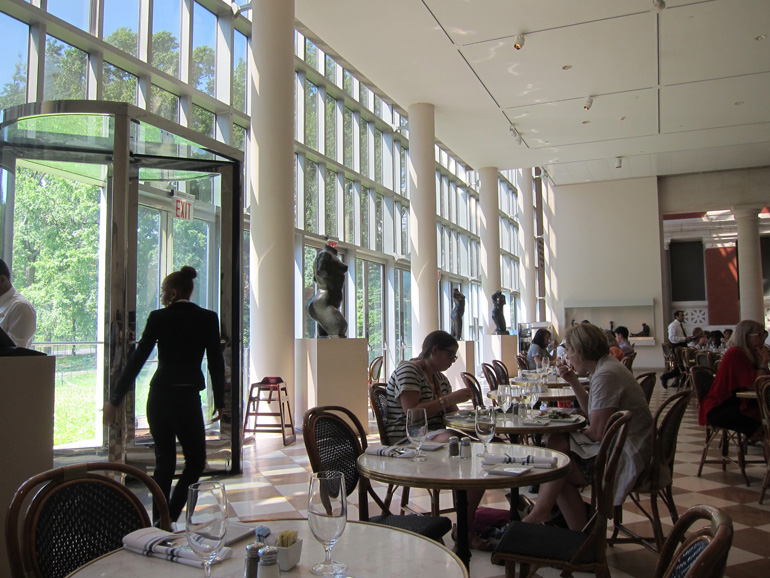Gotham Diary:
Bronze
9 July 2013
After a visit to the ophthalmologist yesterday — a routine checkup with happily routine results — I took a taxi to the Museum, hoping to get to the cafeteria before it stopped serving lunch. As the photograph suggests, I was too late, so I went upstairs to the Petrie Court. Aydimè. The burger that I ordered appeared instantly, before water had had a chance to be poured. While I ate, I attempted to read Dan Auilar’s Vertigo: The Making of a Hitchcock Classic, another book that has stood unread on my shelves since it was published (1998). It was difficult to hold the book open on the small table while gripping the dripping burger, but I managed. After lunch, I went to see the Boxer at Rest.
I’d have missed this great bronze’s visit to the Museum entirely if I hadn’t been prodded by Messir di T. He discovered it during his graduate studies in Rome, and just as excited to see it again in New York as I should be if my favorite Degas, the early Belleli Family, were to reappear in town. Together with Ms NOLA, we went to see the statue last Friday, and I was knocked out by the presence of the thing. It reduced everything else in the Greek and Roman Gallery to the status of plaster cast. I’d never seen anything like it. Small bronzes, yes, Renaissance and baroque bronzes, yes; but never a life-size bronze from antiquity. Few survive; most were melted down by armories. Most seem to have been recovered from the bottom of the Aegean or the Mediterranean. Boxer at Rest was buried, probably in the Fifth Century, to protect it from barbarian predation. There it remained, in the side of the Quirinal Hill, until 1888. Now it stands in the Palazzo Massimo alle Terme. Well, that’s precisely what it doesn’t do now. Now, it’s blocking up the Gallery corridor. How much nicer it would have been to place the bronze in one of the side chambers, along with a few benches. Next week, it will be gone.
Unlike the marble statuary that graces the Gallery, Boxer at Rest is the portrait of an athlete. According to the accompanying brochure, it “draws inspiration from two statues of Herakles sculpted by Lysippos in the fourth century BC,” but a quick Google search fails to return any seated figures. The boxer sits on a boulder, his elbows resting on his thighs, his hands crossed with an easy modesty that, for all his nakedness, screens his privates from most viewpoints. This is not some ideal, some representation of divinity. This is a fighter, bashed up but basically in good trim, taking a breather after a fight and reacting, I think, to hearing something that he doesn’t want to hear. He is incredibly natural.
Which is the conundrum. Why is Boxer at Rest so powerful, when a tour of any gym’s locker room might offer up a very similar sight? He’s just a guy on a bench. And he’s not going to be there for long: his feet make that clear. They are not planted on the ground; this is not a pose. Bronze may have something to do with it; the replacement of skin by dully glowing brown metal is a bit eerie, as though King Midas had been paying a visit on a discount. The metal is in many places somewhat corroded, as well it might be after its thousand-year burial, and this, too, announces the absence of skin. How can something so lifelike not have skin? How can something so lifelike not be alive?
Perhaps the point of the bronze is to allow us to contemplate the boxer as we never could if he were actually present. He would not sit still long enough to contemplate, for one thing. For another, he might want to know what the hell we thought we were looking at. He’s a big guy, almost as tall, I should think, as I am. Broad-shouldered and lean (but for incipient love-handles), clearly strong-legged, the boxer is no brute, but someone who fights with his brain. He’s wired for it. His body is more of a cloak than a weapon, a package for his nervous system. At the same time, there is something crushed about him, some hunching of the shoulders that suggests limited possibilities. Whether or not the boxer is legally a slave, he is as bound to his métier as any successful entertainer. There is nothing for him to do but to keep doing what he does, until the inevitable moment when he cannot do it anymore. It is the boxer’s posture, not his broken nose, cauliflower ears, or dinged forehead, that proclaims his mortality. No, I don’t think that these rich meditations could be triggered by a panting athlete. The living athlete would probably give rise to another line of meditation altogether.
Not to sound too Wallace Stevens-y, but perhaps it is only in inhuman form that we can appraise our humanity. Nobody wants to be bronze.

